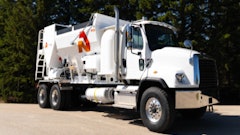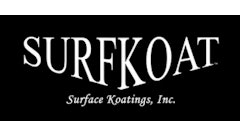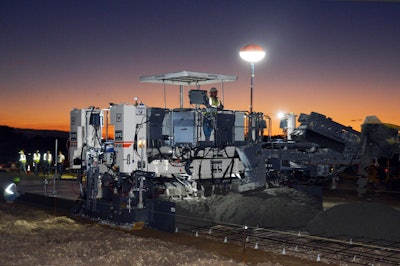
That's the game plan for constructing miles of concrete pavement for a massive residential project now underway on the site of the former Texas World Speedway just south of College Station, and it's one to which the company adheres for most of its concrete paving projects.
There, Larry Young Paving Inc., Bryan, Tex., began paving at 2:30 a.m. and knocked off about 11 a.m. Starting early resolves issues of faulty curing due to the excessive heat of the day, and eliminates hold-ups of mixer trucks in crushing urban traffic.
The development, Southern Pointe Community, ultimately will house some 2,000 residences, businesses and parks. About 100,000 cubic yards of pavements will be constructed there in coming years.
"We're taking the old Texas World Speedway, demolishing it, and putting in a residential development," says Wallace Phillips, developer of the Southern Pointe project. "We're looking at a 12-year development plan within 654 acres, and we're in Phase 1 right now."
Larry Young Paving was founded in August 2005, but Young already had extensive experience in Texas concrete paving. "I've been in the business all my life," says Larry Young, president. "We do public infrastructure concrete paving, like municipal construction, but we also do commercial jobs like shopping malls."
"We self-perform dirt or site work, utility work, asphalt and concrete slipform paving," says Mark Schinzler, operations manager, Larry Young Paving. "On any day we have at least 300 people working for us. We're licensed in Louisiana, Texas, South Carolina and Mississippi."
Initially the firm started as an asphalt paving contractor. "We decided to diversify to chase larger projects, so we added curb-and-gutter concrete to our portfolio, then stepped up to concrete slipform paving, as that's where the market was heading," Schinzler said.
Entrance to Development
Texas loves its concrete. "The governments are looking for longevity and durability," Schinzler says. "For example, the city of College Station now is specifying that all new residential streets be of portland cement concrete, with most of them slipformed."
This gives Larry Young Paving a big advantage, as it's the only contractor in town with a slipform paver, a two-track SP 62i from Wirtgen Group. In October 2018, this paver was put to work in the pre-dawn hours at the Southern Pointe residential development, placing a 2,200 ft.-long pavement 19 ft. in width, some 1,100 cubic yards of concrete. This pavement will serve as a southern grand entrance to the entire development.
"We're placing half the 38-ft.-wide roadway, with a longitudinal joint in the middle using tie-bars," Schinzler says. "As soon as we finish we'll get off of that, and three days later get back on it and place the other side."
Slump of the concrete is 2 to 3 in., Schinzler says. "We need a low slump so it will stand up on the sides and curb," he says. "Consistency of the concrete is very important for the pour, obviously. It's a city mix with crushed river gravel which will reach 3,500 psi in 28 days, but historically it will be close to that in seven days."
Hydraulic vibrators are set at 16 in. spacing and the frequency is 125 vibrations per second. Crown is 3 percent from centerline and is controlled off two stringlines. The SP 62i can run slope control up to 16 ft. (4.5m) if contractors want to run without a string on one side.
Texas DOT slipform paving typically is on a cement- or lime-stabilized base, with an asphalt pavement bond-breaker, topped with fresh concrete, he said, adding cities are doing lime stabilization, then concrete, with no asphalt seam. "This pavement is a jointed concrete pavement, not continuously reinforced, placed on a 6-in. lime-stabilized subgrade, Schinzler says. "We've done both continuous and hand-jointed work with the paver, from 7 in. to 11 in. in depth."
While the work itself is not within the actual city limits of College Station, it lies in an ETJ, an extraterritorial jurisdiction, which under Texas law permits municipalities to control and harmonize development in areas which will be annexed in the future.
In addition to the SP 62i the firm has a WR 2000 XL recycler/reclaimer and a W 150i cold mill from Wirtgen; Vision 5203-2i, Super 1703-3i and Super 1300-2i asphalt pavers from Vögele; and four Hamm tandem rollers, an HD+ 110i VV, HD+ 70i VV, HD 120i VV and HD 14 VV CompactLine roller. The firm also has a Hamm H 10i P single-drum soil compactor.
"We believe in Wirtgen Group equipment," Schinzler says. "We've had huge success with most everything we've bought from them. Their technical and application support is phenomenal, always there to answer questions regarding operations and mechanical from us."
The SP 62i places concrete slabs from 6 ft., 6 in. to 24 ft, wide, and up to 18 in. deep, but also places curb with the right mold. "We're getting new curb molds developed that will let us place a 'lay down' curb, as opposed to a 'stand-up' curb," Schinzler says. "We'll do it with the 62i, pouring monolithically with the pavement. At the track we are doing it all with the curb profile that the city requires."
College Station permits concrete placement at 35 deg F and rising, but that's not been an issue as the ambient working temperatures have been 60 to 80 deg F in October. Temperature of the concrete must be below 95 deg F or the load is rejected. Concrete was supplied by Knife River Corporation.
"That's part of the reason we pour early in the morning," Schinzler says. "That, and traffic concerns, as it's much easier to get the material there that early. In Houston, most of the contractors place their pavements at night and structures during the day. But we do night and day."
Expanding Paver Fleet
Larry Young Paving took possession of its SP 62i immediately after World of Concrete 2018, where this particular machine was the centerpiece of the Wirtgen Group stand.
"We actually bought the machine before it went to Las Vegas, where they used the machine in the exhibit," Young says. "We then transported it back to Houston where it was prepped for us."
"We were champing at the bit for it to get here," Schinzler says. "Within a week we were paving with it. We had some existing older slipform machines, but once we achieved a certain volume of work, we decided we'd look at newer product, that we could gain training on -- eliminating a steep learning curve -- and not have as many issues during a pour as with the older equipment. Now the crews are all experienced with this machine, and are comfortable with paving and getting a good finish."
"One of the incentives to getting this paver was that the manufacturer provided the training at no additional cost," Young says. "If we had bought a used machine we would not have had the benefit. Before we bought the machine we went to Wirtgen's Center for Training & Technology in Nashville and saw the 62i and 92i machines.
"We discussed items we'd like to add, such as the placement conveyor mounted to the front of the machine," Young says. "It's not a standard item and may be the only one like it in the world. Essentially a dedicated placer is mounted to the machine, which we use for narrow widths like 12 ft. where there can be accessibility issues. At the 19 ft. paving width at Southern Pointe it becomes harder to reach, so we have a separate placer for wider widths, which we are using at Southern Pointe. And if the separate placer goes down, we have the paver-mounted placer as a backup."
"A paver-mounted conveyor could detract from smoothness, but Larry Young Paving has proven that a single unit can both place and pave with excellent results," says Tim Nash, Wirtgen director, concrete products. "From a contractor's point of view, this can mean elimination of an entire separate placer unit which essentially doubles the equipment and operating costs, not to mention mobilization costs. In a state like Texas, where there is continuously reinforced concrete pavement (CRCP) everywhere, this could be a really big deal."
Two Tracks
The SP 60i platform of pavers is available in two tracks (SP 62i) and four tracks (SP 64i). "We chose the two-track because we feel it gives the pavement a smoother ride," Schinzler says. "It's also more compact and easier to move. There is a little more to deal with when you have four tracks. There are a few added capabilities that the four-track machine has, but for our purposes, two tracks are quite sufficient. It also has a smaller footprint while paving. And since we do a lot of municipal work, and wanted to have the small placer attached to the front, you could not do that with a four-track model as two of the tracks are placed too far forward."
Quiet operation was another aspect Larry Young Paving looked for in a paver. "If there's one thing that's pretty miraculous, it's how quiet it is when it's running," Schinzler says. "Even as it's running, it's hard to believe that it's even on. When vibration is on, you can feel it, but it's nowhere near our older equipment, which were so loud and the vibration would rattle your teeth. It's a vast improvement, while putting out a phenomenal concrete mat."
The paver is provided with a "Super Smoother" that serves as a robotic float. "It's really handy because you don't ever have to remove it from the machine. Instead of having to remove it before travel, you just fold it up and travel," Schinzler says. "It does a really good job of cutting 'bumps' and finishing the concrete after it comes out of the paver.
The paver also is equipped with the WITOS telematics diagnostic system. "WITOS has helped the maker diagnose equipment codes for us," Schinzler says. "I can't say enough about the support that we've got from the Wirtgen people, either on or off the clock."
That's important, he notes, because the machine is technologically advanced with many multiple options. "There is a lot of technology in this machine that will really, really help you produce a product out the back that other people can't even touch. You're talking about IRI values in the 30s, even pushing into the 20s. You're talking about a smooth, smooth mat."
At day's end, the paver is easy to clean, Young said. "It takes about two to three hours to clean this machine, with its built-in pressure washer," he says. "A lot of people don't take care of their machines the way we do, so ease of cleaning is important to us."
"Our relationship with Larry Young Paving is great," developer Phillips describes. "They are an outstanding contractor. Dealing with them is open and transparent, and they have great crew leaders with whom I visit on a daily basis. Larry is approachable and responsive to our concerns and does a great, quality job."

![Fcp Racatac Chair 10893876[1]](https://img.forconstructionpros.com/mindful/acbm/workspaces/default/uploads/2025/10/fcp-racatac-chair-108938761.10l0At5WXv.png?auto=format%2Ccompress&bg=fff&fill-color=fff&fit=fill&h=100&q=70&w=100)
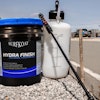



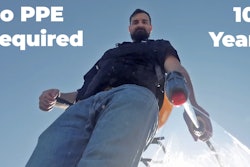


![Fcp Racatac Chair 10893876[1]](https://img.forconstructionpros.com/mindful/acbm/workspaces/default/uploads/2025/10/fcp-racatac-chair-108938761.10l0At5WXv.png?ar=16%3A9&auto=format%2Ccompress&bg=fff&fill-color=fff&fit=fill&h=135&q=70&w=240)





